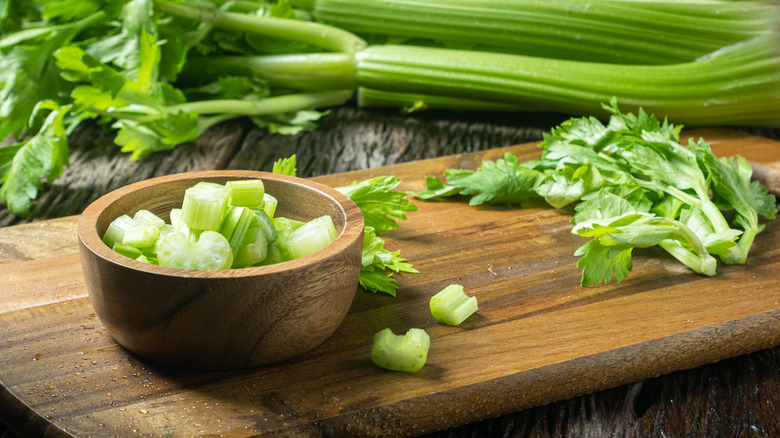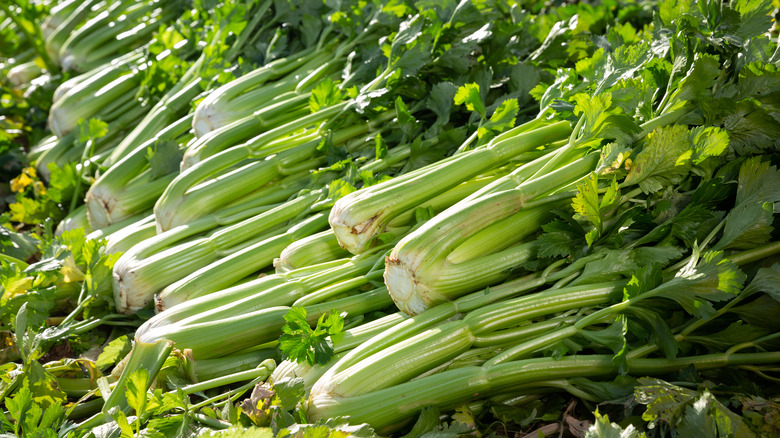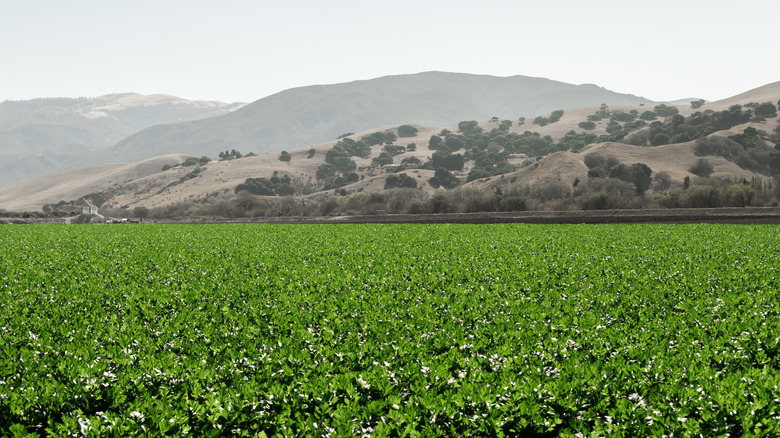Which Country Produces The Most Celery?
When it comes to people's top favorite veggies, celery often goes overlooked. Perhaps it's because of its stringy nature, or maybe it's just too bland for most people's tastes (via The Salad Lobby). Whatever the case may be, when we have vegetables like broccoli, potatoes, carrots, and many other colorful and flavorful plants to pick from, it's hard for the pale and neutral-tasting celery to compete.
It does have its place in the culinary world, though. It is common to find stalks of celery boiled into broths or chopped into things like chicken noodle soup because of its ability to enhance the umami flavors in a dish (via Science20). As a supporting actor, celery is perfect for the role. It is a fantastic way to add texture to your salads and stuffing or to stick into your tried and true Bloody Mary. But when it comes to being the star of the show, celery hardly makes the cut. Even when we eat it raw, we tend to use it as a vehicle for peanut butter or ranch. But there is a lot more to celery than meets the eye.
The history of celery
Celery is a part of the parsley plant family, which makes sense given the look and flavor of the plant (via Britannica). According to botanist Charles Davis of Harvard University, celery is native to the Mediterranean coastline, but research suggests that the plant had been traveling around Europe around 4,000 B.C. and made it to China by the fifth century (via NPR).
The plant is believed by Aggie Horticulture to first have been used as medicine like its relative, parsley, and was used for non-culinary purposes until at least the ninth century in Western Europe. Its seed, however, was used in the ancient East like India and China where Mount Sinai reports that it was used to treat the whole body in matters such as colds, the flu, digestion, arthritis, and liver and spleen dysfunction. If that wasn't enough, the vegetable's seed is also known to act as a mosquito repellent.
Celery as a culinary ingredient
While celery was acknowledged and used by ancestors all over the world, it was used medicinally, not as a culinary ingredient. Italy was the first place that recorded eating celery as a food item in the 1500s, but it wasn't until a century later that the British made any record of the plant they called "sellery." Then, in 1856, a Scotsman named George Taylor introduced celery to the United States (via Ag Hires).
Healthline states that though celery is a relatively under-appreciated veggie stalk, the stringy plant is actually stuffed full of antioxidants, vitamins, and minerals that are great for your general bodily health — so it seems those in the past knew what they were talking about. According to the health site, the best way to enjoy these sticks of nutritional goodness is to buy them with stiff, sturdy stalks with no brown patches and to avoid cutting them or messing with them in general until right before you're going to eat them so they can stay fresh. And don't forget the leaves! Those little suckers are edible too and can be thrown into your next salad.
The US is a powerhouse for celery
In 2019, the U.S. grew 100,482,000 Kg ($126,081.36K) worth of celery and was the No. 1 exporter in the world, followed by Spain and then Mexico (via World Integrated Trade Solution). Celery likes a particular kind of climate, and since it originated off the Mediterranean sea, it makes sense that it thrives best off the coast of California. According to the Almanac, celery prefers cool weather, a consistent source of water, and rich soil, all of which can be found in the Salinas and Santa Maria districts of California (via ediblegardens52). Per Harvest to Table, the best time of year to buy fresh celery is during late spring or during the fall if you prefer your stalks extra fresh and crispy.
The LA Times reports that California grows upward of 28,000 acres of celery, making up 80% of the total annual production in the U.S. The vegetable is mainly grown off the Golden State's coast but is also harvested in Mexico, Arizona, Michigan, and Florida — but not on the massive scale as California does.



